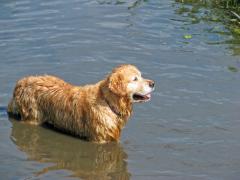Dogs Drinking from Rivers, Lakes, and Oceans

While most pet owners wouldn’t think it is dangerous if their dog takes a few laps from a natural body of water, it can actually be harmful to your pet! Unfortunately, the water in our environment can house various organisms and chemicals, putting your dog – and potentially you – at risk.
A few common bacteria lurking in the outdoor water can be Salmonella, Campylobacter, Escherichia coli and Leptospira. Any of these bacterial infections can lead to diarrhea in dogs and can actually be shed in the stools, having the potential to infect people if handled incorrectly. Leptospira can be one of the worst bacteria that your pet can come into contact with. Leptospira can be found in stagnant, marshy and muddy water that is contaminated by other wildlife, and can actually even develop in puddles. It has the potential to cause liver and kidney damage, even resulting in death. Since it is shed in the urine, people who come into contact with an infected animal could be at risk too.
Another problematic source is blue-green algae. Although it is not a plant, cyanbacteria can form colonies that float on the surface of the water. During swimming or grooming afterwards, dogs can ingest the blooms which can contain toxins, such as microcystins and anatoxins. Microcycstins can cause liver failure, while anatoxins can cause nervous system dysfunction.
Before you let Fido take a drink from any body of water outside, think about the potential hazards. And, if you're worried that your pup might get thirsty on your next outdoor outing, bring along a travel bowl and bottled water or a portable handi-drink style bottle with it's own built-in troth for your dog to get some fresh filtered or even faucet water as an alternative the water that's waiting to make them sick outside!

